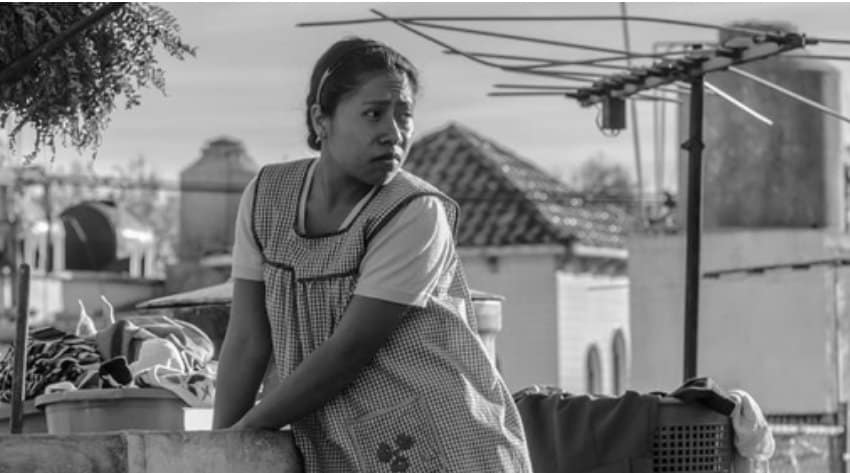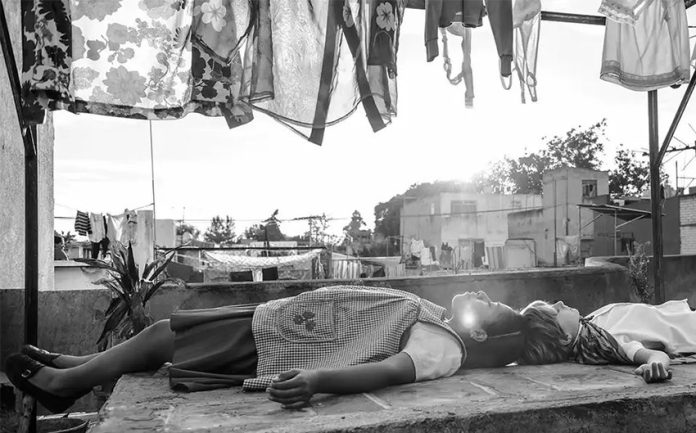Recently, Alfonso Cuarón was awarded best foreign language film and best director at the Golden Globes for Roma. He is fittingly being praised for both technical features and the powerful stories Roma tells about daily life in Mexico in the 1970s.
The film, however, contains other subtle but important elements that have been largely ignored by critics so far.
Two of these elements are Mexico’s political context in the early 1970s and the ongoing conditions that have characterized domestic workers’ lives since. The main character of Roma is Cleo (played by Yalitza Aparicio), a domestic worker based on a woman named Liboria Rodríguez (known as Libo) who worked for Cuarón’s family when he was a child.
Cuarón situates Roma’s characters amid significant historical events: the fight of some Mexicans for social progress and their opposition to a political, authoritarian regime that worked to maintain its privileges through various means.
One of these means is exemplified in the film by the character Fermín — Cleo’s boyfriend (played by Jorge Antonio Guerrero) who belongs to the paramilitary group Los Halcones (The Hawks).
We know now by various direct sources and United States government declassified documents that high-ranking Mexican government officials secretly organized, financed, trained and armed various groups, including Los Halcones, to help quash social movements in the late 1960s and early 1970s.

Los Halcones were composed of around 2,000 young men, aged 18 to 29, distributed in squads of 200 members each.
The squads’ leaders were middle-class university students who, for their participation, received free education, weekly stipends and the promise of a bright future in the ruling Institutional Revolutionary Party (PRI).
The assailants and hitmen were gang members and working class and unemployed young men. They were paid half of what the leaders received.
Los Halcones were also trained by Mexican military and police personnel who, subsidized by USAID, had previously received training at the International Police Academy in Washington.
On June 10, 1971, around 10,000 demonstrators, mainly students, marched to demand improvements to Mexico’s democratic, economic and social conditions.
In Roma, Cleo and others pass these demonstrators on their way to a furniture store. They also pass, in a depiction of real life, a long row of riot police trucks and idle police officers, while Halcones patiently wait at the corner.
Armed with canes and M1 and M2 rifles, Halcones attacked demonstrators, producing the second bloodiest event in modern Mexican history (El Halconazo), only after the Tlatelolco massacre of October 1968.
It is estimated that around 120 people were killed and hundreds more injured, including children, women and seniors. Although the military and uniformed police knew beforehand about the attack, they stood by and did nothing.
Fermín belongs to the second-tier group of Los Halcones. In the hotel, he confesses to Cleo: “I owe my life to martial arts [to Halcones]. I grew up with nothing, you know?”
Portraying the real Halcones youth, Fermín’s participation offered him certain social mobility but only in exchange for committing atrocities.
Some young men’s allegiance to Los Halcones and their corrupt decisions were thus mediated by class aspirations, ideology and violence.
Los Halcones’ violence also manifested in gender violence. This is depicted in Roma when Fermín dismisses his paternity and threatens to beat Cleo and their unborn daughter if she insists on looking for him.
Moreover, despite his low-class background, Fermín ends the scene yelling “gata” at Cleo, an upper class-based insult aimed only at domestic servants, reflecting the latter’s low ascribed social status.
A second element that has not been widely discussed, which Roma touches on, is the historical conditions of domestic workers.
As of June 2018, there were 2.2 million domestic workers in Mexico. Around 95% are women, mostly young and middle-aged (some are even children).
In 2010, 58% of indigenous women in the Monterrey, Nuevo León, metropolitan area were domestic workers. Many migrated from the countryside to the city. This means that, as indigenous migration researcher Séverine Durin asserts, domestic work is strongly shaped by ethnicity.
It is not a coincidence then, that Cuarón’s former nanny Libo or the characters Cleo and Adela in Roma are (young) indigenous women.
Mexican laws do not offer domestic workers the same rights and benefits that other workers enjoy, such as paid sick days and holidays. They can also be dismissed without warning at any time.
Only as recently as December 2018, the Mexican Supreme Court determined that it is unconstitutional for employers to deny domestic workers access to social security, meaning mainly access to public health services.
It is commonplace for domestic workers to face low wages, long working hours and no holidays. Some also experience humiliation, mistreatment and discrimination for speaking their indigenous language, wearing traditional clothes, practising cultural customs and for their physical traits.
Others experience forced confinement or sexual abuse by the men of the family or teenage sons. Yet, domestic workers are expected to thank their employers for the “opportunity” to have a job.
Only one in 10 women file a complaint when they encounter a problem with their employers.
Domestic workers with children also need to make extraordinary arrangements for their own children to be taken care of, meaning prolonged separation many times while they take care of other families’ children. Their caring and affection not only become commodified, but also dislocated.
Some employers consider domestic workers as “part of the family.” However, uneven power relations, class differentials, discrimination and racism make them not really part of the family.
Cuarón mentioned that he was forced to recognize several decades later, and only after he started working on Roma, that Libo was, first, a woman, and second, an indigenous woman. He then realized that Libo belongs to a “world of affective needs, a world of sexual desires,” and also to “a more dispossessed group, a world of injustice.”
In Roma, the family members are unaware of the domestic workers’ social and personal lives.
When Cleo is taken to the delivery room, the grandmother, Teresa, is asked by a nurse about Cleo’s second last name, her date of birth and if she has insurance. But Teresa cannot answer those questions.
Cleo picks up after the family dog, feeds the family, prepares the kids for school, puts them to bed, washes and irons the family’s clothes and cleans the house. Still, the grandmother ignores everything about Cleo despite living in the “same” house (usually, domestic workers sleep and even eat apart from the family).
Cleo is “part of the family” but she is not really part of the family.
Overall, Roma contains various stories that subtly unveil different forms of violence: poverty, social exclusion and gender-based violence promoted by sexist and misogynistic forms of masculinity.
Moreover, domestic workers’ quiet but endless work, which in Roma takes over half of the film, hinders uneven power relations mediated by class, gender, age, affection, ethnicity, race and the urban/rural divide.
These factors intersect to maintain domestic workers, mainly (indigenous) women, in subordinate positions. They are conveniently imagined as “part of the family,” but they are never really part of the family, neither in Mexico, nor in Canada, nor anywhere else in the world.![]()
Alejandro Hernandez is an instructor and PhD candidate in sociology and political economy at Carleton University in Canada. This article is republished from The Conversation under a Creative Commons license.
CORRECTION: The earlier version of this article stated that in 2010, 58% of indigenous women were domestic workers. It should have indicated that the statistic referred to indigenous women in the Monterrey, Nuevo León, metropolitan area.
